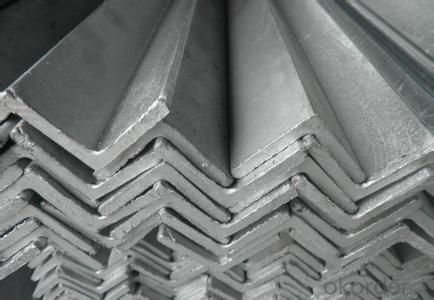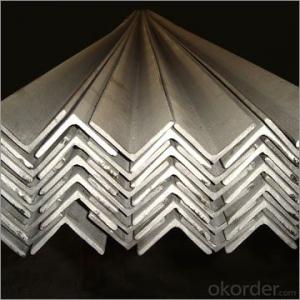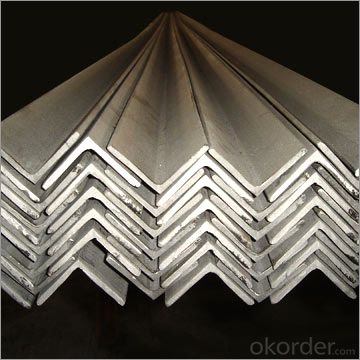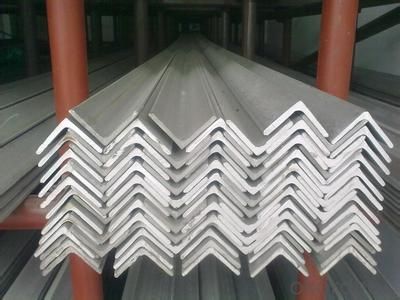Steel Equal Angle And Unequal Angle Steel
- Loading Port:
- Tianjin
- Payment Terms:
- TT OR LC
- Min Order Qty:
- 25 m.t.
- Supply Capability:
- 20000000 m.t./month
OKorder Service Pledge
OKorder Financial Service
You Might Also Like
Specification
Product Description:
OKorder is offering Steel Equal Angle And Unequal Angle Steel at great prices with worldwide shipping. Our supplier is a world-class manufacturer of steel, with our products utilized the world over. OKorder annually supplies products to European, North American and Asian markets. We provide quotations within 24 hours of receiving an inquiry and guarantee competitive prices.
Product Applications:
According to the needs of different structures, Angle can compose to different force support component, and also can be the connections between components. It is widely used in various building structures and engineering structures such as roof beams, bridges, transmission towers, hoisting machinery and transport machinery, ships, industrial furnaces, reaction tower, container frame and warehouse etc
Product Advantages:
OKorder's Steel Steel Equal Angle And Unequal Angle Steel are durable, strong, and resist corrosion.
Main Product Features:
· Premium quality
· Prompt delivery & seaworthy packing (30 days after receiving deposit)
· Corrosion resistance
· Can be recycled and reused
· Mill test certification
· Professional Service
· Competitive pricing
Product Specifications:
Manufacture: Hot rolled
Grade: Q195 – 235
Certificates: ISO, SGS, BV, CIQ
Length: 6m – 12m, as per customer request
Packaging: Export packing, nude packing, bundled
Sizes: 25mm-250mm | ||||||||||||
a*t | ||||||||||||
25*2.5-4.0 | 70*6.0-9.0 | 130*9.0-15 | ||||||||||
30*2.5-6.6 | 75*6.0-9.0 | 140*10-14 | ||||||||||
36*3.0-5.0 | 80*5.0-10 | 150*10-20 | ||||||||||
38*2.3-6.0 | 90*7.0-10 | 160*10-16 | ||||||||||
40*3.0-5.0 | 100*6.0-12 | 175*12-15 | ||||||||||
45*4.0-6.0 | 110*8.0-10 | 180*12-18 | ||||||||||
50*4.0-6.0 | 120*6.0-15 | 200*14-25 | ||||||||||
60*4.0-8.0 | 125*8.0-14 | 250*25 | ||||||||||
FAQ:
Q1: How soon can we receive the product after purchase?
A1: Within three days of placing an order, we will begin production. The specific shipping date is dependent upon international and government factors, but is typically 7 to 10 workdays.
Q2: What makes stainless steel stainless?
A2: Stainless steel must contain at least 10.5 % chromium. It is this element that reacts with the oxygen in the air to form a complex chrome-oxide surface layer that is invisible but strong enough to prevent further oxygen from "staining" (rusting) the surface. Higher levels of chromium and the addition of other alloying elements such as nickel and molybdenum enhance this surface layer and improve the corrosion resistance of the stainless material.
Q3: Can stainless steel rust?
A3: Stainless does not "rust" as you think of regular steel rusting with a red oxide on the surface that flakes off. If you see red rust it is probably due to some iron particles that have contaminated the surface of the stainless steel and it is these iron particles that are rusting. Look at the source of the rusting and see if you can remove it from the surface.
Q2: How do you package the angle steel when shipping?
A2: All goods are packed in bundles with steel strips and shipped by container or break bulk.
Q3: The products are invoicing on theoritical weight or on actual weight?
A3: We can do it in both manners, according to the customers' request.


- Q: How do you calculate the maximum allowable stress for a steel angle?
- To calculate the maximum allowable stress for a steel angle, you need to consider both the material properties of the steel and the specific geometry of the angle. Here are the steps to determine the maximum allowable stress: 1. Determine the material properties: Find the yield strength (or tensile strength) of the steel angle. This information can typically be found in engineering handbooks or material specification documents. The yield strength represents the maximum stress that the steel can withstand without permanent deformation. 2. Consider the safety factor: Determine the desired safety factor for the application. The safety factor represents a margin of safety between the calculated maximum stress and the actual applied stress. Common safety factors range from 1.5 to 4, depending on the specific application and industry standards. 3. Calculate the maximum allowable stress: Multiply the yield strength of the steel by the safety factor. This will give you the maximum allowable stress for the steel angle. The formula is as follows: Maximum Allowable Stress = Yield Strength × Safety Factor For example, if the yield strength of the steel angle is 300 MPa and the desired safety factor is 2, the maximum allowable stress would be: Maximum Allowable Stress = 300 MPa × 2 = 600 MPa Remember to use consistent units throughout the calculation, whether it is in megapascals (MPa), pounds per square inch (psi), or any other unit of stress. It is important to note that this calculation assumes the steel angle is subjected to a uniaxial stress state. If the angle is subjected to bending or torsional loads, additional calculations would be required to determine the maximum allowable stress based on the specific loading conditions and the angle's geometric properties.
- Q: How many kilograms per square meter is angle steel 63*63*6?
- Angle called angle, the steel strip is perpendicular to each other on both sides into the corner. There are equal angles and unequal angles. The two sides of an equal angle steel are equal in width. The specifications are expressed in millimeters of edge width * edge width * edge thickness. Such as "/ 30 x 30 x 3", that is 30 mm width equal angle, edge thickness of 3 mm. Also available models that model is the number of centimeters wide, such as angle 3#. The model does not mean the size of the different edges and sizes of the same model. Therefore, the width, the edge and the thickness of the angle iron should be filled out in the contract and other documents, so as not to be indicated by the model alone. Standard Specification for hot-rolled equal angle iron is 2#-20#.
- Q: How do you connect two steel angles together?
- Two steel angles can be connected together using various methods such as welding, bolting, or using steel angle connectors. Welding involves melting the steel angles together to form a strong bond. Bolting involves using bolts, washers, and nuts to secure the angles together. Steel angle connectors are pre-fabricated brackets that can be used to connect the angles securely. The choice of method depends on the specific application and the desired strength and durability of the connection.
- Q: What are the different dimensions used to specify steel angles?
- The different dimensions used to specify steel angles include the length of each leg, the thickness of the material, and the angle of inclination between the legs.
- Q: How do you determine the torsional stiffness of a steel angle?
- To determine the torsional stiffness of a steel angle, you need to consider its geometry and material properties. First, you should calculate the polar moment of inertia (J) of the steel angle. The polar moment of inertia represents a shape's resistance to torsion and is calculated by summing the products of the differential area elements and their distances squared from the axis of rotation. For a steel angle, you can use standard formulas or reference tables to determine the polar moment of inertia. Next, you need to determine the material properties of the steel angle, specifically its modulus of rigidity (G). The modulus of rigidity measures a material's resistance to deformation under shear stress. This value is typically provided by the steel manufacturer or can be obtained from material property databases. Once you have calculated the polar moment of inertia and obtained the modulus of rigidity, you can determine the torsional stiffness (K) using the formula K = G * J. The torsional stiffness represents the ability of the steel angle to resist twisting or torsional deformation when subjected to a torque. It is important to note that the torsional stiffness of a steel angle can vary depending on factors such as the angle's size, shape, and the specific steel alloy used. Therefore, it is recommended to consult relevant design codes or engineering references to ensure accurate calculations and consider any additional factors that may affect the torsional stiffness.
- Q: How do steel angles contribute to the seismic resilience of a structure?
- Steel angles contribute to the seismic resilience of a structure by providing structural stability and strength. These angles are commonly used as bracing elements to reinforce the connections between different components of the building, such as beams and columns. By distributing and dissipating seismic forces, steel angles help to reduce the impact of earthquakes on the structure. They enhance the overall stiffness and rigidity of the building, preventing excessive deformation and potential collapse during seismic events. Additionally, steel angles can act as energy-absorbing devices, absorbing and dissipating seismic energy, thereby improving the seismic performance and resilience of the structure.
- Q: Can steel angles be used in mining or offshore applications?
- Mining or offshore applications can utilize steel angles. These industries often rely on steel angles for their robustness, longevity, and adaptability. Steel angles are employed for an array of functions, including framing, support, reinforcement, and bracing in mining structures and offshore platforms. Moreover, steel angles possess the capability to endure harsh environments, adverse weather conditions, and corrosive elements frequently encountered in mining or offshore operations. Their capacity to offer structural stability and withstand impact and vibrations renders them well-suited for these applications. All in all, steel angles present a dependable and economically viable option for the mining and offshore sectors.
- Q: Can steel angles be used in modular construction or prefabricated structures?
- Indeed, modular construction or prefabricated structures can indeed utilize steel angles. These versatile and frequently employed structural components possess the ability to furnish modular and prefabricated buildings with both strength and stability. They are capable of constructing the skeletal framework, supporting walls, floors, and roofs, while also reinforcing connections and corners within these edifices. The preference for steel angles arises from their exceptional strength-to-weight ratio, durability, and simplicity in fabrication, rendering them a highly appropriate selection for modular and prefabricated construction endeavors.
- Q: Can steel angles be painted?
- Yes, steel angles can be painted. The steel angles need to be properly cleaned, primed, and then painted using a suitable paint for metal surfaces.
- Q: How are steel angles installed on concrete structures?
- Steel angles are typically installed on concrete structures using anchor bolts. These anchor bolts are drilled into the concrete and then the steel angles are placed over these bolts. Nuts and washers are then tightened onto the anchor bolts to secure the steel angles in place.
Send your message to us
Steel Equal Angle And Unequal Angle Steel
- Loading Port:
- Tianjin
- Payment Terms:
- TT OR LC
- Min Order Qty:
- 25 m.t.
- Supply Capability:
- 20000000 m.t./month
OKorder Service Pledge
OKorder Financial Service
Similar products
Hot products
Hot Searches
Related keywords

























